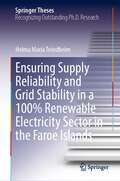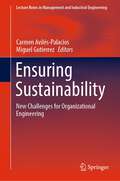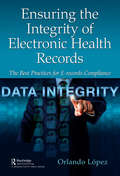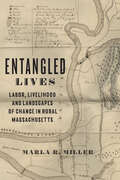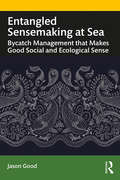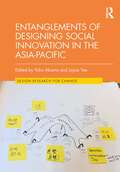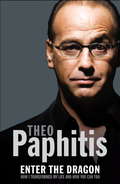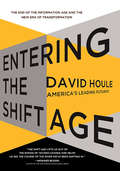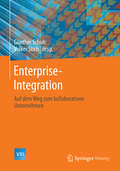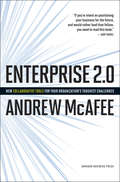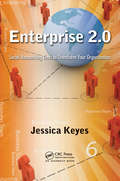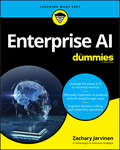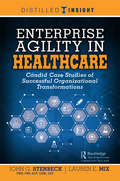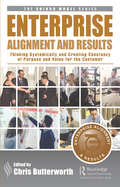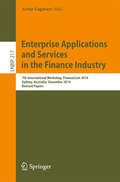- Table View
- List View
Ensuring Better Leaders and Leadership: Implementing the Five Rules of Effective Leadership
by Dave Ulrich Norm Smallwood Kate SweetmanAccording to Dave Ulrich, Norm Smallwood, and Kate Sweetman, there are five rules of effective leadership that comprise a leadership code. However, in order to be useful, rules not only have to be defined, but be used and lead to action. In this chapter, the authors explore ideas about how to use all five elements of the code together to build better leadership and to be a better leader. This chapter is excerpted from "The Leadership Code: Five Rules to Lead By."
Ensuring Safe Foods and Medical Products Through Stronger Regulatory Systems Abroad
by Jim E. RiviereA very high portion of the seafood we eat comes from abroad, mainly from China and Southeast Asia, and most of the active ingredients in medicines we take originate in other countries. Many low- and middle-income countries have lower labor costs and fewer and less stringent environmental regulations than the United States, making them attractive places to produce food and chemical ingredients for export. Safe Foods and Medical Products Through Stronger Regulatory Systems Abroad explains that the diversity and scale of imports makes it impractical for U. S. Food and Drug Administration (FDA) border inspections to be sufficient to ensure product purity and safety, and incidents such as American deaths due to adulterated heparin imported from China propelled the problem into public awareness. The Institute of Medicine Committee on Strengthening Core Elements of Regulatory Systems in Developing Countries took up the vital task of helping the FDA to cope with the reality that so much of the food, drugs, biologics, and medical products consumed in the United States originate in countries with less-robust regulatory systems. Ensuring Safe Foods and Medical Products Through Stronger Regulatory Systems Abroad describes the ways the United States can help strengthen regulatory systems in low and middle income countries and promote cross-border partnerships - including government, industry, and academia - to foster regulatory science and build a core of regulatory professionals. This report also emphasizes an array of practical approaches to ensure sound regulatory practices in today's interconnected world.
Ensuring Supply Reliability and Grid Stability in a 100% Renewable Electricity Sector in the Faroe Islands (Springer Theses)
by Helma Maria TróndheimThis book offers a comprehensive study concerning the reliability of renewable electricity production in the Faroe Islands. The first part reports on a RoadMap with investments in generation, storage and transmission capacity. Multiple scenarios, considering different technologies, are analysed. Practical constraints like the local resource potential, power plant locations and sizes are discussed, as well as the potential of tidal power. The second part of the book describes dynamic simulations studies carried out to investigate grid stability of the power system on the isolated island of Suðuroy. The available information about governor and automatic voltage regulators of the synchronous generators was very limited, therefore different approaches were combined to parameterise and validate the dynamic models. All in all, this book offers extensive information concerning the transition of the Faroese power system into a 100% renewable system. It is practice-oriented, and describes methods that can be applied to other power systems as well.
Ensuring Sustainability: New Challenges for Organizational Engineering (Lecture Notes in Management and Industrial Engineering)
by Carmen Avilés-Palacios Miguel GutierrezThis book presents a selection of the best papers given at the XXIV International Conference on Industrial Engineering and Industrial Management. The conference is promoted by ADINGOR (Asociación para el Desarrollo de la Ingeniería de Organización) and organized by the Universidad Politécnica de Madrid and the Universidad Carlos III de Madrid. It took place at the Universidad Carlos III de Madrid (Leganés, Spain) in July 2020. Ensuring Sustainability embodies the latest advances in research and cutting-edge analyses of real case studies in industrial engineering and operations management from diverse international contexts. It also identifies business applications for the latest findings and innovations in operations management and the decision sciences.
Ensuring Your Family's Future: The Alagil Family Office
by Esel Cekin Lauren H. Cohen Fares KhraisMuhammad Alagil was a second-generation leader in the well-known Alagil Family Group of businesses in Saudi Arabia and co-founder and chairman of its family office, Jarir Company for Commercial Investments (Jarir Investments). The case opens in 2021 with Alagil pondering whether or not to allow family members of the next generations aged 35 and over to spin off their pieces of the trust and set out on their own. This change would have been a massive departure from the state of mind he and his four brothers shared for the past decades: Why would anyone leave and shrink the pie? He was confident that none of the third generation (G3) would leave but he knew there was no guarantee they would stay either. He also knew that, when their time came, a portion of G4 members (the eldest of whom was 12 years old) would likely exercise that right and leave. With the sustainability of the family office in mind, would it be disastrous if some members left? The case discusses whether it was the G2 members' responsibility to entice future generations to stay and, if so, how? If not, should they at least come up with a mechanism to ensure that future generations would survive on their own?
Ensuring Your Family's Future: The Alagil Family Office (B)
by Esel Cekin Lauren H. Cohen Fares KhraisMuhammad Alagil was a second-generation leader in the well-known Alagil Family Group of businesses in Saudi Arabia and co-founder and chairman of its family office, Jarir Company for Commercial Investments (Jarir Investments). The case opens in 2021 with Alagil pondering whether or not to allow family members of the next generations aged 35 and over to spin off their pieces of the trust and set out on their own. This change would have been a massive departure from the state of mind he and his four brothers shared for the past decades: Why would anyone leave and shrink the pie? He was confident that none of the third generation (G3) would leave but he knew there was no guarantee they would stay either. He also knew that, when their time came, a portion of G4 members (the eldest of whom was 12 years old) would likely exercise that right and leave. With the sustainability of the family office in mind, would it be disastrous if some members left? The case discusses whether it was the G2 members' responsibility to entice future generations to stay and, if so, how? If not, should they at least come up with a mechanism to ensure that future generations would survive on their own?
Ensuring the Integrity of Electronic Health Records: The Best Practices for E-records Compliance
by Orlando LópezData integrity is a critical aspect to the design, implementation, and usage of any system which stores, processes, or retrieves data. The overall intent of any data integrity technique is the same: ensure data is recorded exactly as intended and, upon later retrieval, ensure the data is the same as it was when originally recorded. Any alternation to the data is then traced to the person who made the modification. The integrity of data in a patient’s electronic health record is critical to ensuring the safety of the patient. This book is relevant to production systems and quality control systems associated with the manufacture of pharmaceuticals and medical device products and updates the practical information to enable better understanding of the controls applicable to e-records. The book highlights the e-records suitability implementation and associated risk-assessed controls, and e-records handling. The book also provides updated regulatory standards from global regulatory organizations such as MHRA, Medicines and Healthcare Products Regulatory Agency (UK); FDA, Food and Drug Administration (US); National Medical Products Association (China); TGA, Therapeutic Goods Administration (Australia); SIMGP, Russia State Institute of Medicines and Good Practices; and the World Health Organization, to name a few.
Entangled Lives: Labor, Livelihood, and Landscapes of Change in Rural Massachusetts (Studies in Early American Economy and Society from the Library Company of Philadelphia)
by Marla MillerAn enlightening look at American women's work in the late eighteenth century.What was women's work truly like in late eighteenth-century America, and what does it tell us about the gendered social relations of labor in the early republic? In Entangled Lives, Marla R. Miller examines the lives of Anglo-, African, and Native American women in one rural New England community—Hadley, Massachusetts—during the town's slow transformation following the Revolutionary War. Peering into the homes, taverns, and farmyards of Hadley, Miller offers readers an intimate history of the working lives of these women and their vital role in the local economy. Miller, a longtime resident of Hadley, follows a handful of eighteenth-century women working in a variety of occupations: domestic service, cloth making, health and healing, and hospitality. She asks about the social openings and opportunities this work created—and the limitations it placed on ordinary lives. Her compelling stories about women's everyday work, grounded in the material culture, built environment, and landscapes of rural western Massachusetts, reveal the larger economic networks in which Hadley operated and the subtle shifts that accompanied the emergence of the middle class in that rural community. Ultimately, this book shows how work differentiated not only men and woman but also race and class as Miller follows young, mostly white women working in domestic service, African American women negotiating labor in enslavement and freedom, and women of the rural gentry acting as both producers and employers. Engagingly written and featuring fascinating characters, the book deftly takes us inside a society and shows us how it functions. Offering an intervention into larger conversations about local history, microhistory, and historical scholarship, Entangled Lives is a revealing journey through early America.
Entangled Sensemaking at Sea: Bycatch Management That Makes Good Social and Ecological Sense
by Jason GoodSustainable commercial fishing, species conservation, and bycatch are contentious topics. Great emphasis has been placed on the sustainable sourcing of particular species that we buy at the store and order in restaurants, but how can we trust that the fish on our plates, from a system-wide perspective, have been appropriately sourced? Even in what are commonly considered to be the best-managed fisheries in the world (i.e., Alaskan fisheries), thousands of tons of fish are wasted each year in the interest of providing certain species in certain ways to certain people, at certain prices. Are the management practices and regulations that we think are helping actually having the desired outcomes in terms of the effective use of natural resources? This book presents a framework that can enhance our understanding, research, and regulation of frontline organizing processes in commercial fisheries, which may be generalized to other resource extraction industries. It enables readers to better grasp and respond to the need to develop practices and regulations that involve effective use of all natural resources, rather than just a chosen few. The book is especially important to researchers and practitioners active in the fishing industry, and natural resource managers and regulators interested in understanding and improving their management systems. It is also highly relevant to organization and management researchers interested in coupled human and natural systems, ecological sensemaking, the role of quantum mechanics in organizational phenomena, sociomateriality, and sustainability. The book uses the real-world case of an Alaskan fishing fleet to explore how the commercial fishing industry (which includes businesses, management agencies, regulatory bodies, and markets, among others) entangles itself with natural phenomena in order to extract resources from them. After gaining a better understanding of these processes can we see how they can be improved, especially through changes to regulatory management systems, in order to foster not only more sustainable, but also less wasteful (these two goals are not necessarily interdependent in today's regulatory management systems), natural resource extraction and use. Such an understanding requires exploring how regulations, natural phenomena, human sensemaking processes, and market forces entangle at sea to materialize the fish that make their way to our plates - as well as those that, importantly, do not.
Entanglements of Designing Social Innovation in the Asia-Pacific (Design Research for Change)
by Yoko AkamaRooted in the places, cultures, histories, and wisdom of the diverse Asia-Pacific region, this book gathers heterogeneous practices of designing social innovation that address various social, political, and environmental challenges. In contrast to dominant notions of design from the Global North that evolved through industrialisation and modernist thinking, the examples in this book speak to designing that is embodied, relational, temporal, ontological, and entangled deeply with ecologies. This edited volume shares rich and detailed stories from Aotearoa New Zealand, Cambodia, Indonesia, Japan, Malaysia, Myanmar, the Philippines, Samoa, Thailand, Vanuatu and a continent now called Australia, that offer honest and critical reflections from practitioners and scholars on designing social innovation. Contributors explore issues of ethics, politics, and positionality in their work. This book highlights the importance of respecting multiple knowledge streams, worldviews, and practices situated in a place. This then supports a plurality of designing social innovation. In all, this book offers ways to sharpen focus on entangled pluralities as a central condition for designing. It is a contribution of hope and inspiration that are becoming more urgently needed in the volatile uncertainties of this world. This book will be of interest to scholars working in social innovation, service design, social design, participatory design, design anthropology, and Asian studies.
Enter the Dragon
by Theo PaphitisClassic rags-to-riches story by entrepreneur and Dragons' Den star Theo PaphitisTheo Paphitis is the outspoken and charismatic star of Dragons' Den who has turned round a string of household names, from Ryman to La Senza, in a high-profile business career that has brought him millions. Now, in his revealing and controversial memoir, he not only takes the reader behind the scenes on Dragons' Den, he explains how he made his fortune. He also provides a masterclass in business methods that will enable anyone who reads this book to learn so much about how they too can improve their business.In the book, Theo recalls how his family moved to England from Cyprus and how as a poor immigrant, he took whatever jobs he could, starting as a tea boy for Lloyd's. There he began to take the first steps on a career that would net him a fortune. He reveals the methods that took him to the top, and also provides some fascinating insight into the national game from his spell as chairman of Millwall FC. But, above all, this is a book that will provide all readers with the opportunity to learn from one of the nation's most successful businessmen and put his ideas into practice.
Enter the Dragon
by Theo PaphitisClassic rags-to-riches story by entrepreneur and Dragons' Den star Theo PaphitisTheo Paphitis is the outspoken and charismatic star of Dragons' Den who has turned round a string of household names, from Ryman to La Senza, in a high-profile business career that has brought him millions. Now, in his revealing and controversial memoir, he not only takes the reader behind the scenes on Dragons' Den, he explains how he made his fortune. He also provides a masterclass in business methods that will enable anyone who reads this book to learn so much about how they too can improve their business.In the book, Theo recalls how his family moved to England from Cyprus and how as a poor immigrant, he took whatever jobs he could, starting as a tea boy for Lloyd's. There he began to take the first steps on a career that would net him a fortune. He reveals the methods that took him to the top, and also provides some fascinating insight into the national game from his spell as chairman of Millwall FC. But, above all, this is a book that will provide all readers with the opportunity to learn from one of the nation's most successful businessmen and put his ideas into practice.
Entering the Shift Age
by David HouleThe Information Age? Think again. Change is everywhere: how we communicate, what we do for a living, the values we hold, the way we raise our children, even the way we access information. Thanks to a global economy, the force of the Internet, and the explosion of mobile technology, we have--almost imperceptibly--been ushered into a new era, the Shift Age, in which change happens so quickly that it's become the norm. Man-made developments--such as tools, machines, and technology--defined previous ages, but the Shift Age will be defined by our own power of choice. In Entering the Shift Age, leading futurist David Houle argues that we are going through a major collapse of legacy thinking, eroding many of the thought structures that have defined the last two hundred years of humanity. Houle identifies and explains the new forces that will shape our lives--including remote workplaces, the cloud, "24/7" culture, speed-of-light connectivity, creativity, and the influence of Millenials and Digital Natives--for the next twenty years. In this eye-opening book, Houle navigates this pivotal point in human history with clarity and anticipation, focusing on the power of human consciousness and the direct influence we can impart on everything from healthcare to media to education. According to Houle, we are more independent than ever before. We are in control. There's no "going back" to the way things were. Reality is changing ever faster, and ENTERING THE SHIFT AGE is your guide to keeping up.
Entering the Shift Age: The Transformation Decade 2010-2020
by David HouleWe are leaving the Information Age and transitioning into the Shift Age, a time of transformation and change that offers both great risk and incredible opportunity. In Entering the Shift Age, David Houle identifies and explains the dynamics and forces that have shaped our world and will continue to reshape our world for the next 20 years. He shows how the Shift Age means a world fully global yet focused on the individual, where the speed of change is so fast that change itself is the new norm. He also comments from the front lines of the Shift Age on issues and topics that affect our lives, from business and technology to environment, media and global culture. The Transformation Decade ebook examines the fundamental changes going on in 2010-2020 as we transition from the Information Age into the Shift Age, and what you need to be aware of as we navigate these important years.
Entering the Shift Age: Welcome to the Shift Age
by David HouleWe are leaving the Information Age and transitioning into the Shift Age, a time of transformation and change that offers both great risk and incredible opportunity. In Entering the Shift Age, David Houle identifies and explains the dynamics and forces that have shaped our world and will continue to reshape our world for the next 20 years. He shows how the Shift Age means a world fully global yet focused on the individual, where the speed of change is so fast that change itself is the new norm. He also comments from the front lines of the Shift Age on issues and topics that affect our lives, from business and technology to environment, media and global culture. The Welcome to the Shift Age ebook serves as an introduction to the concept of the Shift Age: how we got here, what is changing, and where we are going.
Enterprise -Integration: Auf dem Weg zum kollaborativen Unternehmen (VDI-Buch)
by Günther Schuh and Volker StichDas Buch beschreibt den betriebsorganisatorischen und logistischen Fortschritt , indem es das Thema „Enterprise-Integration“ als zukunftsweisenden Impuls aufnimmt. Ausgangshypothese ist, dass zukünftig die stete Weiterentwicklung bestehender Strukturen und Prozesse zur Sicherung der Wettbewerbsfähigkeit allein nicht mehr ausreichend wird. Vielmehr steht die Frage im Vordergrund, wie das Wertschöpfungssystem insgesamt gestaltet werden muss, um das Potenzial einzelner Technologien auch langfristig ausspielen zu können. Die Integrativität komplexer Wertschöpfungssysteme wird damit zu einem Gestaltungsparadigma betriebsorganisatorischer Forschung.Der Inhalt„Enterprise-Integration“ fügt Themen wie „Industrie 4.0“, „Cyber-physikalische Systeme“, „Ubiquitous Technologies“ und „Industrialisierung des Services“ zu einer Idee neuer Wertschöpfungssysteme zusammen. Dazu erarbeiten namhafte Autoren in einzelnen Sachbeiträgen Zukunftsvisionen, die in ein umfassendes Konzept eingeordnet werden.Die ZielgruppenSowohl Forscher als auch trendinteressierte Industrievertreter können diesem Buch wichtige Informationen zu den wirtschaftlichen Herausforderungen der Zukunft entnehmen.
Enterprise 2.0
by Andrew Mcafee"Web 2.0" is the portion of the Internet that's interactively produced by many people; it includes Wikipedia, Facebook, Twitter, Delicious, and prediction markets. In just a few years, Web 2.0 communities have demonstrated astonishing levels of innovation, knowledge accumulation, collaboration, and collective intelligence.Now, leading organizations are bringing the Web's novel tools and philosophies inside, creating Enterprise 2.0. In this book, Andrew McAfee shows how they're doing this, and why it's benefiting them. Enterprise 2.0 makes clear that the new technologies are good for much more than just socializing-when properly applied, they help businesses solve pressing problems, capture dispersed and fast-changing knowledge, highlight and leverage expertise, generate and refine ideas, and harness the wisdom of crowds.Most organizations, however, don't find it easy or natural to use these new tools initially. And executives see many possible pitfalls associated with them. Enterprise 2.0 explores these concerns, and shows how business leaders can overcome them.McAfee brings together case studies and examples with key concepts from economics, sociology, computer science, consumer psychology, and management studies and presents them all in a clear, accessible, and entertaining style. Enterprise 2.0 is a must-have resource for all C-suite executives seeking to make technology decisions that are simultaneously powerful, popular, and pragmatic.
Enterprise 2.0: Social Networking Tools to Transform Your Organization
by Jessica KeyesEnterprise 2.0 (E 2.0) has caught the collective imagination of executives who are innovating to radically change the face of business. E 2.0 takes full benefit of social networking, including blogs, discussion boards, mashups, and all that is sharable and combinable.Examining organizations and their social activities, Enterprise 2.0: Social N
Enterprise AI For Dummies
by Zachary JarvinenMaster the application of artificial intelligence in your enterprise with the book series trusted by millions In Enterprise AI For Dummies, author Zachary Jarvinen simplifies and explains to readers the complicated world of artificial intelligence for business. Using practical examples, concrete applications, and straightforward prose, the author breaks down the fundamental and advanced topics that form the core of business AI. Written for executives, managers, employees, consultants, and students with an interest in the business applications of artificial intelligence, Enterprise AI For Dummies demystifies the sometimes confusing topic of artificial intelligence. No longer will you lag behind your colleagues and friends when discussing the benefits of AI and business. The book includes discussions of AI applications, including : · Streamlining business operations · Improving decision making · Increasing automation · Maximizing revenue The For Dummies series makes topics understandable, and as such, this book is written in an easily understood style that’s perfect for anyone who seeks an introduction to a usually unforgiving topic.
Enterprise Agility For Dummies
by Doug RoseManage and improve your organization's agile transformation Adopting an enterprise agile framework is a radical organizational change, and this book will help you get there without ever breaking a sweat. In Enterprise Agility For Dummies, you'll discover how to successfully choose and implement the right framework based on your organization's own unique culture. Organizational culture is one of the most overlooked challenges when trying to make a change to enterprise agile, and there are lots of resources out there that claim to have the perfect, one-size-fits-all solution. Luckily, this book takes a neutral stance and covers popular organizational change management techniques that you can implement to suit to your unique needs. Packed with step-by-step instruction and complemented with real-world case studies, this book offers everything you need to know in order to embrace a more agile mindset. Understand the benefits of an agile approach Pick the best enterprise agile framework for your organization Create a successful enterprise change management plan Let Enterprise Agility For Dummies help you optimize your business processes, and watch your productivity soar.
Enterprise Agility at Komercni Banka
by Suraj Srinivasan Sarah Gulick Euvin NaidooIn 2017, Jan Juchelka, the new CEO of Komercni Banka, identified long term goals for the bank's progress. To do so, he began to shift the bank to an agile organizational structure. The case describes the bank's transformation, including the timeline for each department's move to agile, pitfalls, and the training and selection of managers. The case also describes the hiring of new employees in order to fill specialized IT roles, and the selection of McKinsey and Co. as advisors. The case asks what the next steps are for Komercni Banka, and what parts of the agile structure were still necessary to achieve.
Enterprise Agility in Healthcare: Candid Case Studies of Successful Organizational Transformations
by John G. Stenbeck Lauren E. MixEnterprise Agility in Healthcare explains why agility is vital to organizational survival. It details the critical variables that only executive leaders can address in a way that ensures success. It uses the experiences of two major healthcare organizations in order to frame the situational context surrounding the variables and then explains why and how the leaders in those organizations made choices that proved to be extraordinarily successful … in the real world! The common challenge shared by healthcare, aerospace, and information-centric industries of every type is the extraordinary complexity and uncertainty driven by the enormous number of individual, yet codependent factors, whether in humans and their cellular functioning, or vehicles and the interaction of materials and environment, requiring leaders and decision-makers at every level to connect, interact, and synthesize vital, fluctuating data, typically via technology-intermediated network structures with varying content and scale. The networks may be obvious, like the organizational structure, while others are more abstract or virtual, like social networks and ecosystems Despite healthcare’s amazing success in improving the quality and average lifespan of human beings, the maximum lifespan remains unchanged at no more than 125 years. Very few healthcare organizations live for much longer, with most disappearing before reaching one-third of that lifespan. How systems, people, and culture respond as organizational size changes is a challenge and also an opportunity in scaling for any information-centric industry. This book will use the actual, real-world experiences of two, very successful healthcare organizations to provide specific, actionable insights into the principles and practices that provoke success. Because scaling plays a determinative role in the successful design of everything from airplanes to skyscrapers, its impact on how effective and efficient an organization is remains a continuous challenge. Perhaps understanding scaling is of greater urgency due to the increasingly large and complex structures required for companies, institutions and governments to continuously evolve the complex adaptive systems they have become. This book focuses on organizational expansion in healthcare. By examining two organizations with similar, yet very different growth experiences, this book demonstrates very successful, very real outcomes while offering key insights into the principles and practices that drove them.
Enterprise Agility: A Practical Guide to Agile Business Management
by Gizem OzbayracDespite the astonishing technological developments in our times, it is surprising how little has changed in the way organizations are structured and managed. However, organizations are finally changing as they embark on agile transformations. Agility concepts emerged from the dynamics of project management and have evolved as they are being applied to organizational structure and operations. This phase of the agile evolution is known as enterprise agility. Filled with real-world scenarios and company case studies, Enterprise Agility: A Practical Guide to Agile Business Management covers the evolution of agility, including applied processes, lessons learned and realized outcomes. The book starts with the initial phase of the agile evolution, project agility and describes how waterfall project management is transformed into scrum, which can have positive effects on project timelines, scope and budget, as well as team motivation. The second phase of agility, organizational agility, is the evolution of the agile principles from temporary projects to permanent organizational structures. The book explains the main components of organizational agility, including structures, roles and ways of organizing work. It emphasizes the advantages of transitioning from traditional organizational management to agile. Finally, the latest phase, enterprise agility, transforms each function of the organization. The book acts as a guide and describes the change through the lens of each managerial domain (sales, marketing, HR, finance etc.) and by presenting the positive impact generated on the company’s overall performance based on case studies. The last chapter illustrates the enablers of this transformation and how they can help the change to be internalized so that the enterprises realize improvements. The book is based on the author’s over 15 years of experience of supporting more than 25 companies in varied sectors on their transformational journey, with the last 5 years concentrating on agility. By combining business management trends and principles of agile business development, it shows managers how to lead the transformation to enterprise agility by following the path from project agility to full enterprise agility.
Enterprise Alignment and Results: Thinking Systemically and Creating Constancy of Purpose and Value for the Customer (The Shingo Model Series)
by Chris ButterworthTo succeed, an organization must cultivate management systems that effectively align their work and behaviors with principles and direction. These systems should be simple, comprehensible, actionable, and standardized. Establishing alignment in every value stream of an organization will ultimately create value for their customers and produce the desired results. This alignment stems from an understanding of why an organization exists, where it is going, and how it will get there. Enterprise Alignment and Results guides readers to their goal of enterprise-wide alignment by providing a deeper look at the Shingo Model. This book builds upon the previous books in the Shingo Model Series by continuing to define ideal behaviors and the systems that drive them and increasing understanding of fundamental beliefs and how to use behavioral benchmarks. As readers examine the principles of "Create Constancy of Purpose," "Think Systemically," and "Create Value for the Customer," they will gain a deeper knowledge of the relationship between behaviors, systems, and principles. This knowledge will foster an understanding of how to create alignment within their organizations, thereby increasing the consistency of delivering ideal results.
Enterprise Applications and Services in the Finance Industry
by Artur LugmayrThis book constitutes the proceedings of the 7th International Workshop on Enterprise Applications and Services in the Finance Industry, FinanceCom 2014, held in Sydney, Australia, on December 12, 2014. The workshop spans multiple disciplines, including technical, service, economic, sociological, and behavioral sciences. It reflects on technologically enabled opportunities, implications, and changes due to the introduction of new business models or regulations related to the financial services industry and the financial markets. The nine papers presented were carefully reviewed and selected from numerous submissions.

